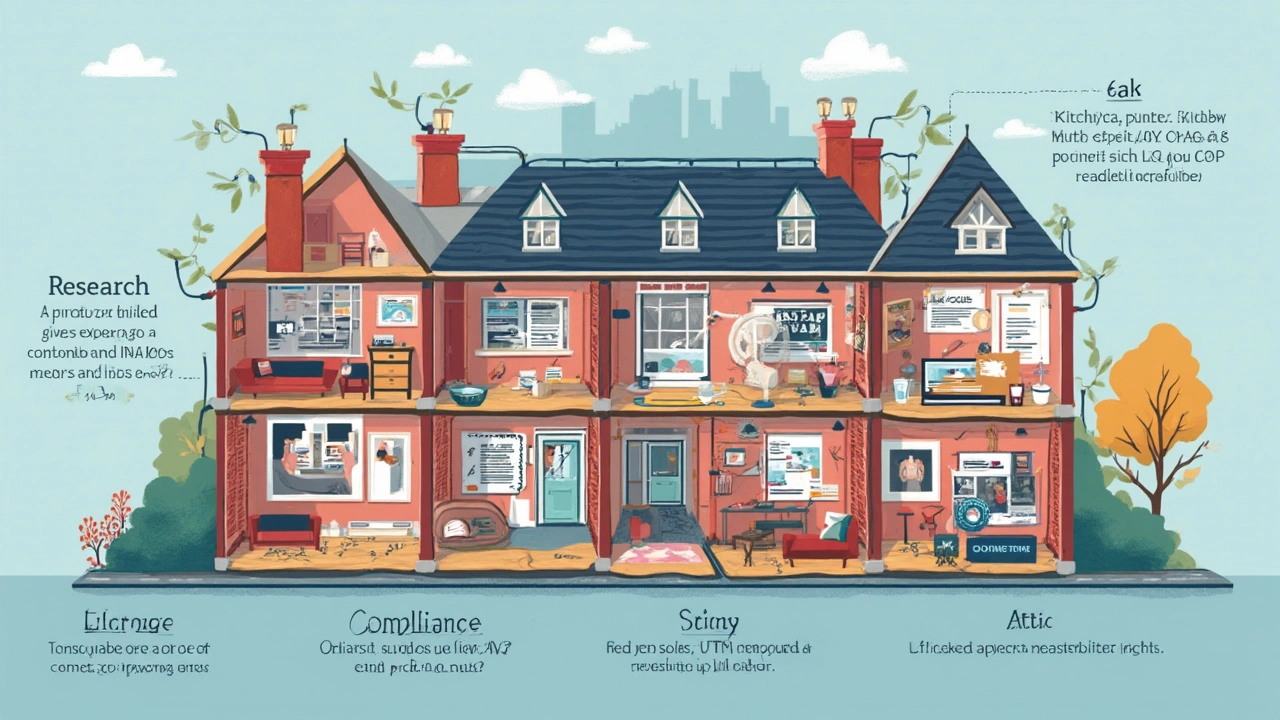Affiliate earnings get squeezed by higher ad costs, pickier audiences, and search updates that punish low-value content. ChatGPT won’t fix a weak offer, but used with a clear workflow it can shorten research, sharpen copy, and lift conversions without breaking rules. This piece shows how to build a lean, AI-assisted affiliate engine you can run in hours per week-not months.
- TL;DR: Use ChatGPT to speed up research, briefs, and rough drafts; keep humans for proof, E-E-A-T, and monetization choices.
- Follow a repeatable workflow: niche math → offer fit → content briefs → on-page draft → compliance → launch → measure → iterate.
- Track 4 numbers: EPC, CR, AOV, RPM. Make micro-edits to lift CR by 0.3-0.7%-that’s usually worth more than writing another post.
- Obey FTC/ACCC guidelines and your program T&Cs; label affiliate links and AI assistance when it matters.
- Ship fast, but only publish content that answers the searcher’s exact task better than the current top 3.
Why ChatGPT is the new affiliate edge in 2025
Most affiliates lose time in the middle: turning rough ideas into briefs, creating first drafts, and editing for clarity. That’s where ChatGPT shines. It’s not a replacement for experience or compliance, but it’s a force multiplier for research, structure, and persuasive language.
I work from Adelaide, so my day starts when US traffic is winding down. I batch research at night and ship in the morning. ChatGPT helps me shave hours off product comparisons and audience research so I can spend more time on conversion lifts-things like CTA placement, bonuses, and angle testing.
Here’s the rule I use: AI for draft speed, human for truth and trust. You let ChatGPT outline, compare, and brainstorm. You validate claims, add personal proof, and choose offers. That division lines up with what Google and regulators care about: usefulness, accuracy, and transparent endorsements. Google’s public guidance in 2024 says AI-generated content isn’t penalized on its own; low-value, scaled spam is. The difference shows in attention to detail and accountability-your name, your screenshots, your refund story.
Let’s get practical. Imagine you run content for mid-priced coffee gear. Without AI, a best grinder review takes 8-10 hours end to end. With a good workflow, you can finish in 3-4 hours without cutting corners on testing and compliance.
| Task | Traditional | With ChatGPT | Risk Control |
|---|---|---|---|
| Keyword + intent mapping | 1-2 h | 20-30 min (seed + clustering) | Validate search results and SERP features manually |
| Outline + brief | 1 h | 10-15 min | Lock headings to match intent; remove fluff |
| First draft | 4-5 h | 40-60 min | Replace generic claims with first-hand notes/screenshots |
| Edit for conversion | 1-2 h | 45-60 min | Test CTA placement and bonus stack; check disclosures |
Why this works: ChatGPT is fast at pattern work-summaries, comparison structures, plain-language explanations. You keep ownership of facts, taste, and the offer. That’s the mix that earns clicks and trust.
Compliance note you can’t ignore: The FTC’s Endorsement Guides (updated 2023) require clear disclosures when you earn from links. In Australia, the ACCC expects plain, prominent disclosures and no misleading claims. Amazon’s Associates Operating Agreement bans price guarantees and certain incentive language. These are primary sources; read them before you scale.
One more baseline: pick a keyword only if your page will do the searcher’s job better than the current top three. Otherwise, keep it for a cluster piece and rank through internal linking and topical depth.

Step-by-step: build an AI-assisted affiliate engine
Here’s the exact workflow I run. It’s simple and deliberate, with checks so you don’t ship risky or weak content. Use it as a template and tweak to your niche.
-
Do the money math first (offers and niche viability). You need a path to profit before you write a word.
- EPC (earnings per click) = Commission ÷ Clicks. Aim for baseline EPC that covers content costs within 90 days.
- CR (conversion rate) = Sales ÷ Clicks. New sites often sit at 0.5-1.5%; strong intent pages can hit 3-8%.
- AOV (average order value) matters more than commission rate alone. A 3% fee on $600 can beat 10% on $50.
- RPM (revenue per mille) = (Total earnings ÷ Sessions) × 1000. Track this at the page level.
-
Map intent and cluster the topic. Use ChatGPT to brainstorm and group search tasks, then verify manually.
- Prompt: “You are an SEO content strategist. Given seed topic ‘manual coffee grinders’, list 10 high-intent queries (commercial or transactional), 10 supporting informational queries, and the user’s job-to-be-done for each.”
- Open the SERP for the target query. Note result types: review lists, single product reviews, buying guides, videos, forums. If top results are mostly forums or YouTube, build an embedded video angle or Q&A section.
-
Pick the right offer and angle. This is where human judgment matters.
- Rule of two: Choose two primary merchants so you’re not captive to one policy or out-of-stock issue.
- Angle examples: “Quietest for apartments”, “Best under $150”, “Travel-friendly”, “Best for hand strength”. ChatGPT can list angles; you decide which aligns with proof you can show.
-
Create a conversion-first brief in 15 minutes. Ask ChatGPT for a brief that matches intent, but lock your own CTAs and proof plan.
- Prompt: “Build a content brief for ‘best manual coffee grinder for travel’ targeting buyers who value durability and weight. Include: H2/H3 outline, comparison criteria table headers, FAQ from People Also Ask, CTA placements (top, mid, bottom), and a checklist.”
- Force compare criteria you can verify: weight, grind settings, burr type, warranty, handle lock, bag size fit.
-
Draft fast, add real proof, and disclose. Let ChatGPT draft paragraphs you’ll refine.
- Prompt: “Write 120 words explaining burr material differences (steel vs ceramic) in simple language, with one practical scenario for travelers.”
- Add your stuff: photos, weight on a scale, a 30-second clip, or a chat with support about warranty. That’s your E-E-A-T.
- Disclosure that travels with the user: a short, plain notice near the first CTA and in the footer. Don’t bury it.
-
Optimize the page for action, not just keywords. Small edits move revenue more than another paragraph.
- Put a sticky comparison bar near the top for mobile. Keep it 3-5 options with one “Best for…” tag each.
- Use just one CTA verb per page (“Compare prices” or “See deal”). Consistency matters.
- Add a “Why trust me” box with 3 bullets: time using the product, tests you ran, and your return/refund experience.
-
Ship, instrument, iterate. Publish and watch behavior quickly.
- Set link tracking by button location: top, middle, bottom. You’ll see where readers click first.
- Check Search Console for the query mix in 7-14 days. If impressions rise for a misaligned query, add a section that addresses it without derailing the page.
- Run one change at a time: headline, first CTA placement, or price framing. Give it a week unless traffic is huge.
Time-saver automations that don’t get you in trouble:
- Idea inbox: New user questions from email/social go to a spreadsheet. A Zap sends the row to ChatGPT for outline suggestions. You still approve and write.
- Brief generator: Drop a keyword and 5 competing URLs; ChatGPT returns a gap-based outline. You strip redundancy and lock the angle.
- FAQ refresh: Every quarter, feed recent Search Console queries to ChatGPT to propose 3 new FAQs. Manually verify and update.
Avoid risky automations: mass autopublish, fake author bios, or invented quotes. Google’s spam policies call out scaled low-value content and fabricated signals, and programs like Amazon do audit affiliates for compliance and misrepresentation.
Prompt patterns that convert:
- “You are a skeptical buyer with a $200 budget. Challenge my recommendation for [Product]. List 5 objections and a fair response to each.”
- “Turn these specs into a benefit ladder for apartment dwellers: [paste specs]. Keep to 80 words.”
- “Write 3 callouts for a comparison table highlighting [unique feature], each under 12 words, no hype.”
- “Draft a price disclaimer in plain English for affiliate links where prices change often.”
Seasonality matters if you sell across regions. For me in Adelaide, winter promotions hit June-August while US readers are in summer. I keep two calendars: one for AU events (EOFY, Boxing Day) and one for US/CAN (Black Friday/Cyber Monday). ChatGPT can propose campaigns, but your real sales history should decide timing.

Playbooks, prompts, checklists, and troubleshooting
Below are the ready-to-run pieces most readers ask for after the first build: the conversion playbook, compliance checklist, and how to debug a page that won’t convert. Save these and reuse.
Playbook 1: The 90-minute comparison post
- 15 min research: Confirm intent and shortlist 3-5 products you can verify.
- 15 min brief: Ask ChatGPT for outline, criteria, and FAQs. Trim to essentials.
- 30 min draft: ChatGPT writes body; you add proof and photos.
- 15 min optimize: Add sticky table, CTA alignment, trust box.
- 15 min compliance + ship: Disclosures, price disclaimers, and program checks.
Playbook 2: The post-update rescue (when rankings wobble)
- Benchmark: Pull last 28 days vs previous 28 for impressions, CTR, position, and RPM.
- Gap scan: Paste top 3 competitors’ headings and key features into ChatGPT; ask for missing sub-topics and Proof-of-Experience ideas.
- Refocus intent: If the SERP shifted to video or single-product, adjust the page or split into new assets.
- Reinforce trust: Add first-hand notes, new photos, FAQs answered with data, and a clear author bio.
Playbook 3: The pre-launch offer check
- Program terms: Check commission, cookie, paid search rules, and brand bidding limits.
- Supply: Confirm inventory and shipping windows with the merchant; avoid dead links during peaks.
- Angle: Ask ChatGPT for 3 ethical bonus ideas that add real value (setup checklist, quick-start video, printable sizing guide).
- Disclosure: Prepare a short, obvious disclosure near the first CTA.
Cheat sheet: micro-optimizations that typically lift CR
- Shorten product paragraphs to 2-3 sentences, then a scannable bullet list of pros/cons.
- Lead with a “best for [use-case]” tag on each product card so readers self-select fast.
- Replace “Buy now” with “Check price at [Merchant]”-it feels safer and gets more clicks.
- Move shipping or return info above the fold; it calms anxiety for bigger-ticket items.
- Show one personal drawback per product. Honest negatives build trust and reduce returns.
Compliance and ethics checklist
- Disclose paid relationships and affiliate links clearly. The FTC’s 2023 Guides and ACCC guidance both expect conspicuous placement in plain language.
- Don’t fake availability, discounts, or countdown timers. Many programs ban false urgency.
- Price disclaimers: “Prices change often; the price you see is set by the retailer at checkout.”
- Images and reviews: If you didn’t take the photo, credit appropriately and stay within license. Don’t invent testimonials.
- AI use: If you materially used AI to draft, and your audience expects disclosure, add a short note. It’s not required everywhere, but it builds trust.
Analytics: what to measure and how to act
- EPC: Track by page and by merchant. If one merchant lags 30% behind on the same clicks, rotate links or change default buttons.
- CR by device: If mobile CR is half of desktop, fix CTA sizing, spacing, and sticky elements first.
- Scroll + click heatmap: If users stop before the comparison table, move your first CTA up and compress the intro.
- Query mix: In Search Console, filter queries with “vs”, “best”, or “review”. If you’re getting “how to use…” queries on a comparison page, add a short section and internal link to a full guide-don’t bloat the main page.
Example prompts you can copy
- “Create a comparison criteria matrix for [product category] that balances durability, warranty, and usability for [audience]. Output just the header row.”
- “Rewrite this product summary to remove hype and use concrete, measurable benefits: [paste 120 words]. Cap at 90 words.”
- “From these three competitor pages, what are the top 5 gaps we can fill with first-hand experience? [paste headings or notes]”
- “Suggest a 45-character headline that matches commercial intent without clickbait for the query ‘best [category] under $[price]’.”
Real-world example (consumer tech)
When I covered mid-range ANC earbuds, the first draft from ChatGPT read well, but conversions were flat. The fix wasn’t more words; it was specificity. I added a 20-second clip comparing mic quality on a windy Adelaide afternoon, plus a chart of battery life tested on two commutes. CR lifted from 1.2% to 2.1% with the same traffic. The copy stayed simple; the proof did the heavy lifting.
Mini-FAQ
Is AI-written content safe for SEO? Yes, if it’s helpful, accurate, and reviewed by a human. Google targets unhelpful scaled content and fabricated authority, not the tool itself. Add evidence and accountability.
Will programs ban me if I use ChatGPT? Programs don’t ban tools; they ban behavior. Violations include misleading claims, scraping, and fake reviews. Read the Operating Agreement and advertising policies for your merchants.
Do I need to disclose that I used AI? There isn’t a universal legal requirement. If AI assistance might affect how a reasonable reader perceives your content, a short note helps. Always disclose affiliate relationships.
What if I don’t have products on hand? Be honest. Use crowd-sourced insights and specs, but say you haven’t tested it yourself. Focus on comparison clarity, warranty terms, and return policies. Get hands-on as soon as you can.
How often should I update posts? Quarterly for evergreen content, monthly during peak seasons or when merchants change models. Refresh based on query shifts and merchant stock, not just dates.
Next steps
- Pick one high-intent topic and run the 90-minute comparison playbook this week.
- Set up link tracking by button location to find your best click zones.
- Write a reusable disclosure and price disclaimer that fits your voice.
- Build a one-page analytics view: EPC, CR, RPM by page and merchant.
Troubleshooting
- Traffic but no clicks: Your CTAs may be buried or vague. Move one above the fold and change the verb to “Check price at [Merchant]”.
- Clicks but no sales: Switch default merchant to the one with higher conversion on similar traffic; review mismatch between angle and landing page (shipping, color, variant).
- Ranking drop after an update: Reassess intent; add first-hand proof and tighten the intro. If the SERP favors single-product reviews, split your content.
- Compliance warning: Remove any price guarantees or fake scarcity. Ensure disclosures are visible near the first CTA and at top of the page.
- AI hallucinations: Never let ChatGPT invent specs or quotes. Paste official specs and limit the model to rewriting and structuring them. Verify with the manufacturer page.
One final tip: bank small wins. A 0.4% conversion lift across five money pages can beat a new post that never ranks. Keep your stack simple, your claims honest, and your pages fast. That’s the sustainable way to use ChatGPT affiliate marketing as a real edge-less time thrashing, more time earning.


I am a passionate marketing strategist with 20 years of experience, specializing in online marketing. I work closely with both domestic and global clients to create powerful and effective marketing campaigns. My articles about the latest online marketing trends are shared and read worldwide. Besides, my love for writing led me to start my own marketing blog. My objective is to bridge the gap between brands and their consumers using digital marketing tools.